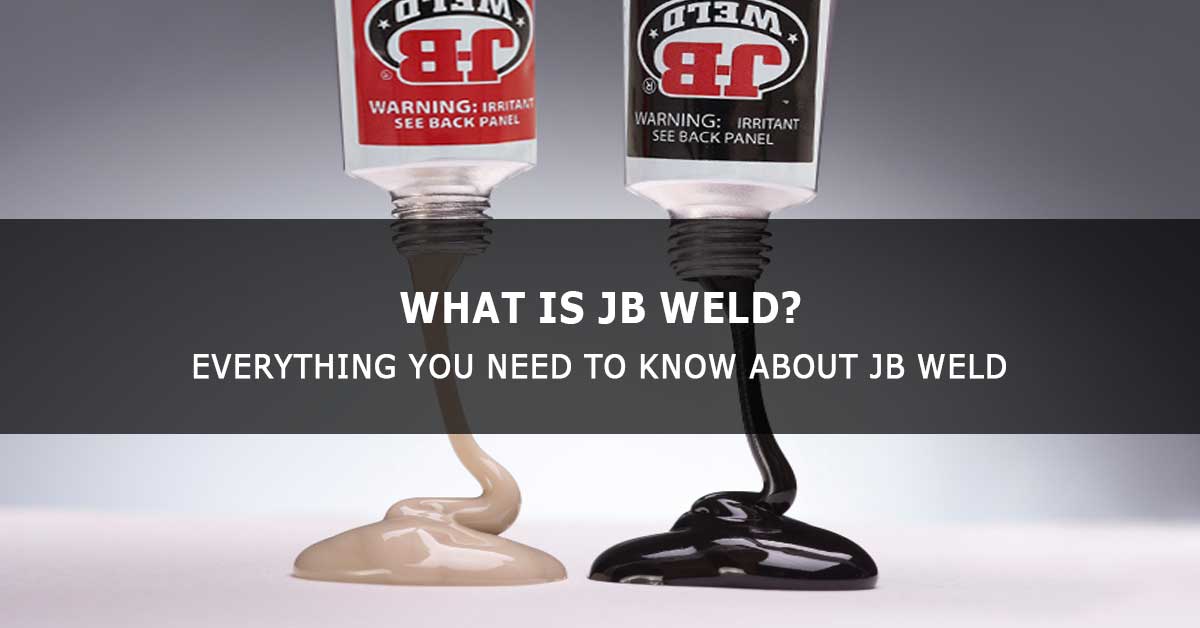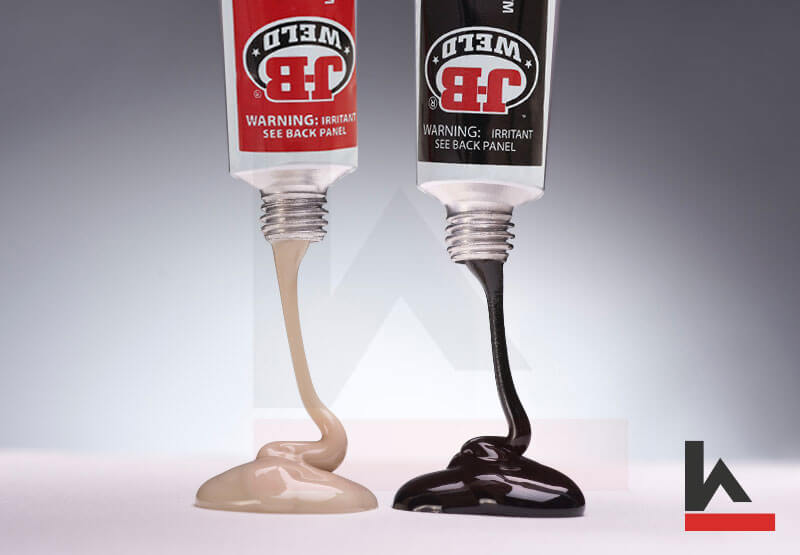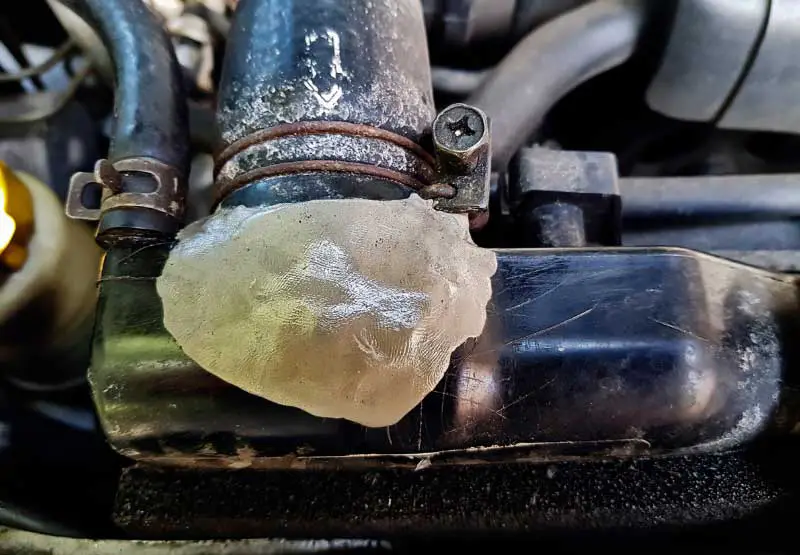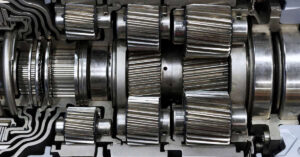If you have a broken part or need to repair something, you will use JB Weld. JB Weld (J-B Weld) is an adhesive product developed by a company called JB Weld. It was originally designed for automotive repair but has since become one of the most popular bonding solutions ever.
To get the most out of your JB Weld, you will need to understand what it is and how it works. While this may seem like ordinary epoxy glue, it is a specialized product that has become one of the most popular uses for various repair jobs.
This article introduces you to everything you need to know about finding the right application for JB Weld, along with the different types available for purchase.
What is JB Weld?
JB Weld is a two-part epoxy adhesive widely used for bonding various materials such as metal, wood, brick, concrete, fiberglass, plastic, leather, rubber, and vinyl. The composition of the J-B Weld consists of two main components: the resin and the hardener. The resin acts as the principal adhesive, while the hardener catalyzes the curing process.
J-B Weld is not recommended on some materials, including items that require flexibility (like rubber), resistance to heat and chemicals (like Teflon or silicone), and painted surfaces.
The curing process of the J-B Weld involves time for the adhesive to harden and bond to the surfaces. The set time for JB Weld is about 4-6 hours under normal conditions, but JB Weld takes up to 15-24 hours for the adhesive to become fully strong. Using a heat lamp, heat gun, or hairdryer can accelerate the curing process, while humidity levels and environment temperature can slow it down.
Why to Use JB Weld?
J-B Weld can bond and fix a wide range of materials, making it a versatile and worthwhile investment for homeowners, DIY enthusiasts, and professionals. Here are some of the benefits of purchasing J-B Weld:
Versatility: J-B Weld is an all-in-one solution that can fix a variety of materials, including metal, wood, plastic, concrete, ceramic, and more.
High strength: J-B Weld is known for its exceptional bonding strength. It can withstand up to 5,000 PSI of pressure, making it a reliable option for repairs that must withstand significant stress.
Heat-resistance: J-B Weld can withstand extreme heat, up to 600°F, without losing its bonding strength. This makes it perfect for use in high-heat areas, such as engine parts, exhaust systems, and other automotive repairs.
Chemical resistance: J-B Weld is resistant to a wide range of chemicals, such as gasoline, oil, and hydraulic fluids, which makes it ideal for repairs involving these substances.
Adaptable: J-B Weld is designed to be used in challenging conditions and environments. It can maintain strength and bonding even in humid, wet, or cold weather conditions.
How to use J-B Weld
J-B Weld is a two-part epoxy that can bond various materials, from metal to plastic and wood. But since it cures through a chemical process, it’s important to use it properly to ensure a strong bond.
Here’s a step-by-step guide on how to use JB Weld:
1. Surface Preparation: It’s crucial to prepare the surface properly before applying JB Weld. Clean the surface of any dirt, dust, or grease using a cleaning solvent or soap. Dry the surface entirely with a clean towel or cloth. Make sure the surface is entirely dry before moving to the next step.
2. Mixing: Once the surface is clean and dry, mix the two components of the J-B Weld in equal proportions. Use a disposable tool, like a piece of cardboard or plastic, to mix the two components thoroughly until the color is uniform.
3. Application: After mixing the two components of the JB Weld, apply the adhesive to the surface using the disposable tool or other applicators. It’s important to apply the adhesive evenly, ensuring no air bubbles could weaken the bond. Spread the adhesive smoothly and evenly, working it into all the nooks and crannies.
4. Curing: The JB Weld adhesive takes time to cure fully, so it’s important to let it sit undisturbed for at least eight hours or overnight. The curing time could vary depending on the type of J-B Weld used and other environmental factors like temperature and humidity. Once cured, the J-B Weld will provide a durable and long-lasting bond.
What are J-B Weld’s best Applications?
JB Weld can be used for a wide range of applications, making it a go-to product for DIY enthusiasts, automotive, and household repairs.
One of the best applications for a J-B Weld is in metal repairs. It creates a strong bond resistant to extreme temperatures, pressure, and chemicals like gasoline and oil. This makes it perfect for repairing cracks or breaks in engine blocks, exhaust manifolds, and other metal components.
JB Weld is also a great choice for wood repairs. It can fill in cracks or splits in wooden furniture, door frames, and even outdoor decking. It can also be sanded and painted over, giving it a seamless finish that blends in with the surrounding wood.
Concrete and fiberglass are two other materials that J-B Weld works well with. It can help repair cracks in concrete driveways and walls and even be used to patch holes in fiberglass boats or other structures.
To ensure the best results when using J-B Weld, following the instructions carefully and using it only on dry surfaces is important. Additionally, it’s not recommended for use on flexible or rubber surfaces, as J-B Weld dries to a hard, inflexible finish.
Different Types of JB Weld
JB Weld offers different types of epoxy products to suit different applications. Here are some of the most popular types of JB Weld and their functions.
1. JB Weld Original: JB Weld Original is the flagship product of this brand. This type of J-B Weld is perfect for household repairs, fixing leaks in pipes, and bonding metal surfaces.
2. JB Weld Steel Stick: This type of J-B Weld is specifically designed for repairs to metal. It has a high tensile strength and is perfect for repairing pieces of metal that have broken or need to be bonded.
3. JB Weld Plastic Bonder: This type of J-B Weld is made for bonding plastic surfaces. It is perfect for fixing broken plastic items, including toys, car parts, and household appliances.
4. JB Weld Cold Weld: This type of J-B Weld is designed for use in low temperatures and can bond a various materials.
5. JB Weld KwikWeld: This J-B Weld product is a fast-curing version that can create a strong bond in just a few minutes.
No products found.
JB Weld Cure Time – Set Time
When it comes to using JB Weld for your household repairs or automotive repairs, it’s essential to consider its cure time.
While JB Weld is known for its permanent bond and strong adhesive, the curing process can take 15-24 hours. However, several things must be remembered to make the curing process faster and more efficient.
Why J-B Weld has to Cure?
One drawback of JB Weld is that it takes time to cure completely. The curing time is affected by various factors, such as temperature, humidity, and the thickness of the bond.
J-B Weld cures through a chemical reaction between the two parts of the epoxy. This chemical reaction can be slowed down or accelerated depending on temperature and humidity levels. JB Weld generally cures best at temperatures between 50°F and 80°F and under low humidity conditions.
It’s important to note that J-B Weld should be allowed to fully cure before putting it under any significant stress. While it may harden relatively quickly, it can take up to 4-6 hours to set and up to 15-24 hours to fully cure and reach maximum strength.
Placing it under heavy stress too soon can compromise the bond and result in a weak repair that fails sooner than expected.
What Happens During the Curing Process?
When JB Weld is applied, it consists of two parts that must be mixed together before use. This mixture creates a chemical reaction known as an exothermic reaction. This means that heat is generated as a natural byproduct of the chemical reaction.
As J-B Weld cures, the exothermic reaction produces heat which initiates the hardening process of the two-part epoxy. The generated heat plays a pivotal role in causing the epoxy to harden, as it activates the chemical bond between the two parts. This process produces a dense and permanent bond that can withstand significant stress without breaking.
It’s essential to note that the heat generated by the curing process can cause damage to the cured object or the surrounding surfaces. It’s important to be mindful of this when using J-B Weld and take precautions to avoid overheating during curing.
How to Make JB Weld Cure Faster?
Waiting for JB Weld to cure can be a tedious and time-consuming process. You may wonder if there is an easier way to speed up the JB weld curing process. Fortunately, there are various methods to accelerate the curing process of the J-B Weld.
1. Using a hair dryer or heat gun: Apply low heat to the repaired area, moving the heat source back and forth about 2 inches from the surface. This method will shorten the curing time by 30-50% and can be especially useful in cold weather.
2. Submerging the area in hot water: Fill a container with hot water (not boiling) and place the repaired item in it. The hot water will help speed up the chemical process and reduce curing time by 50%.
3. Using a lamp or sun exposure: Placing the repaired item under a heat lamp or in direct sunlight can help speed up the curing process. Keep the item about 12 inches from the heat source and rotate it every few minutes to ensure even curing.
4. Using oven: Preheat the oven to 200°F and place the repaired item inside for 30 minutes. This method can shorten the curing time by up to 80%.
5. Using a UV light: Apply the JB Weld to the repaired surface and position the UV light directly above it. Keep the surface within 2 inches of the light source and shine the light on it for at least 5-10 minutes.
6. Thin layer Application: Apply a thin layer of JB Weld instead of a thick layer. A thin layer will dry faster since it has less material to cure.
It is important to remember that these alternative methods may weaken the bond and should be used with care.
JB Weld Curing Factor (Temperature and Humidity)
The cure rate of JB Weld is significantly affected by both temperature and relative humidity. Generally, increasing the temperature and decreasing the relative humidity result in an accelerated cure rate, but there are few exceptions.
Humidity can significantly impact the cure rate of JB Weld, where a high level of moisture in the air can increase the time required for the curing process. Additionally, it is crucial to note that higher humidity levels can also cause the epoxy to become soft and may not reach the desired strength.
Temperature is another critical variable that affects the cure rate of J-B Weld. Higher temperatures speed up the cure time, resulting in a faster curing process. In contrast, colder temperatures tend to slow down the curing rate significantly.
Activation temperature is another factor to consider in the J-B Weld curing process. Many epoxies require high temperatures to activate the curing process, but JB Weld has a lower activation temperature of just 50 degrees Fahrenheit. This lower activation temperature ensures that the curing process can begin, even in relatively cooler environments.
The amount of mixture applied between the two J-B Weld compounds is also essential in determining the set time. If the mixture is applied unevenly or in a small quantity, it may take longer to cure, resulting in longer set times.
By considering these factors, you can ensure that the curing process proceeds optimally and results in a strong, permanent bond.
JB Weld Alternatives
While JB Weld is an exceptional product for bonding materials together, there are times when you might consider alternatives that offer similar properties and benefits. Here are some alternatives to JB Weld that you might want to consider using:
1. Gorilla Glue: Gorilla Glue is a popular alternative to JB Weld, offering great bonding strength and versatility. It is ideal for use on various materials, including wood, metal, ceramic, and more. One of the key advantages of Gorilla Glue is its ability to bond to slightly wet surfaces, making it ideal for use in humid environments.
2. 3M Marine Adhesive Sealant: 3M Marine Adhesive Sealant is an excellent option for those seeking a high-strength adhesive in marine environments. It can be used for bonding fiberglass, wood, metal, and other materials, making it versatile enough to meet various bonding needs. It is also waterproof, making it ideal for use in marine environments.
3. Loctite Epoxy Weld: Loctite Epoxy Weld is another great alternative to JB Weld, offering high bonding strength and chemical resistance. It is ideal for use on various materials, including metal, concrete, and plastic.
4. Permatex Liquid Metal Filler: Permatex Liquid Metal Filler is a great option for repairing pipe leaks and other metal surfaces. It forms a durable bond and can withstand heat and pressure. It is also water-resistant, making it ideal for use in humid environments.
5. Quick Steel: Quick Steel is another two-part epoxy putty that offers excellent bonding strength and durability. It can be used on various surfaces, including metal, wood, ceramic, and plastic. It can withstand extreme temperatures and forms a waterproof bond resistant to chemicals.
While these alternatives to JB Weld offer unique strengths and weaknesses, they all provide similarly high-strength bonding abilities as J-B Weld. When selecting an alternative, it is important to consider the nature of the materials being bonded, the environment in which the bonding occurs, and the specific needs of the repair.
Frequently Asked Questions
How Strong Is JB Weld?
While JB Weld may not be as strong as welding, which results in a permanent bond, it can still achieve a strong, permanent bond that can withstand forces of up to 5,000 psi. We can consider it a cold welding process.
J-B Weld is an excellent alternative to welding, especially in difficult-to-reach areas or on surfaces that cannot be welded. It can bond pieces of metal and various other materials, creating a reliable solution for repairs that require maximum strength.
How Long Does It Take for JB Weld to Dry?
The drying process for JB Weld begins within 4-6 hours, during which the adhesive starts to set. However, the bond is still at its full strength during this period. J-B Weld takes about 15-24 hours to reach its maximum strength and be ready for use.
It’s essential to note that several factors influence these drying times.
Is JB Weld Conductive?
The adhesive contains metal particles, giving it its characteristic grey appearance. These metal particles may make one assume that J-B Weld conducts electricity, but this is not the case.
JB Weld is considered an insulator, meaning it does not conduct electricity. While the metal particles in J-B Weld might give it a metallic appearance, they are not enough to make it conducive.
It is essential to remember this when deciding the appropriate adhesive to use for a specific repair. A conductive adhesive such as silver epoxy may be more suitable for electrical components than JB Weld.
How To Remove JB Weld?
Once JB Weld has cured, it can be quite tricky to remove. Since no solvents are available to dissolve it, the only solution is to use mechanical methods.
Start by grinding the surface of the cured JB Weld. Begin with a coarse grit sanding disk to remove as much of the material as possible. Be careful not to apply too much pressure, which can damage the underlying surface.
Once you have removed most of the J-B Weld, switch to a finer grit sanding disk and continue smoothing out the surface. Remember that this process may take some time, especially if the cured material is thick or covers a large surface area.
Can You use JB Weld in high temperatures applications?
Yes! JB Weld can be used in extreme temperatures, and its ability to withstand high temperatures is one reason why it is popular in automotive and household repairs.
J-B Weld can withstand extreme temperatures up to 550 degrees Fahrenheit, but it is crucial to know the cure time and temperature requirements and to follow the manufacturer’s instructions closely.
Using J-B Weld without meeting these requirements can result in a weaker bond that may fail when exposed to extreme temperatures.
Will JB Weld cure underwater?
Yes, JB Weld can cure underwater. J-B Weld makes a specific product for underwater repairs called JB Water Weld Epoxy Putty. This two-part epoxy putty is specially designed to cure and bond underwater. It is ideal for repairing leaks in pipes, tanks, pools, boats, and other underwater vehicles.
Is JB Weld Gasoline and Water Resistant?
JB Weld is an exceptional product for repairing automotive components or other machines that come into contact with gasoline or various automotive fluids. Once it has cured, J-B Weld becomes resistant to gas, oil, and other automotive fluids due to the epoxy resin and hardener that constitute it.
Which is better JB Weld or KwikWeld? J-B Weld vs KwikWeld
JB Weld can effectively join metals, wood, concrete, and fiberglass, making it a versatile option for various projects. However, J-B Weld takes approximately 24 hours to cure fully, so the project must be left untouched during that period.
On the other hand, KwikWeld is another two-part epoxy that sets faster than J-B Weld. This fast-setting feature makes it ideal for metal repairs that require a quick fix, and it is also widely applicable to other surfaces. However, KwikWeld is more specialized than J-B Weld and works best on metal surfaces.
J-B Weld is your best bet if you need an all-purpose glue for various surfaces. And, if you require a fast-setting glue mainly for metal surfaces, then KwikWeld is the ideal solution.
Conclusion
In conclusion, selecting the right epoxy adhesive for a project is crucial in achieving a successful and long-lasting result. JB Weld stands as a reliable and widely applicable option for bonding a variety of materials and surfaces, and its strength and permanence have been proven time and time again.
It’s important always to follow the manufacturer’s instructions for cure times, application methods, and safety precautions that need to be considered. This ensures the bond strength and curing time are optimized for the best possible adhesion.







